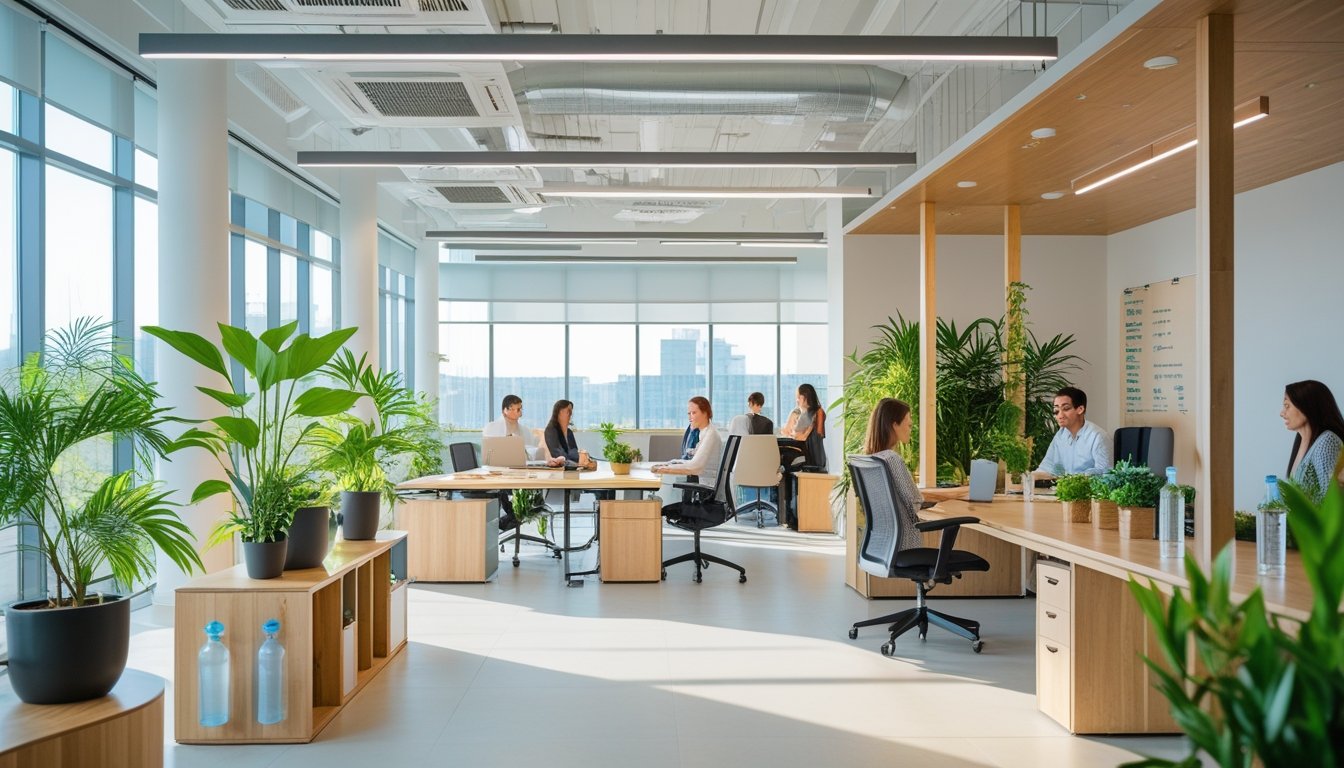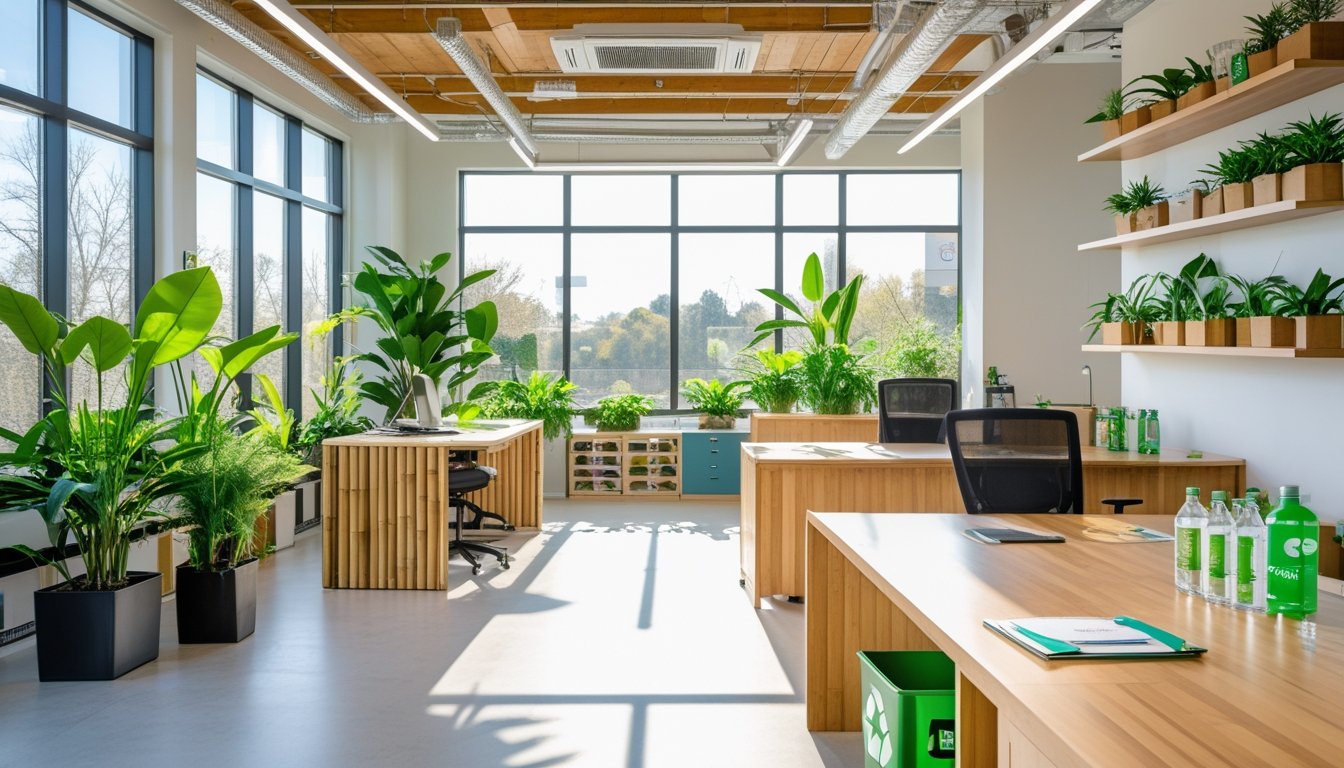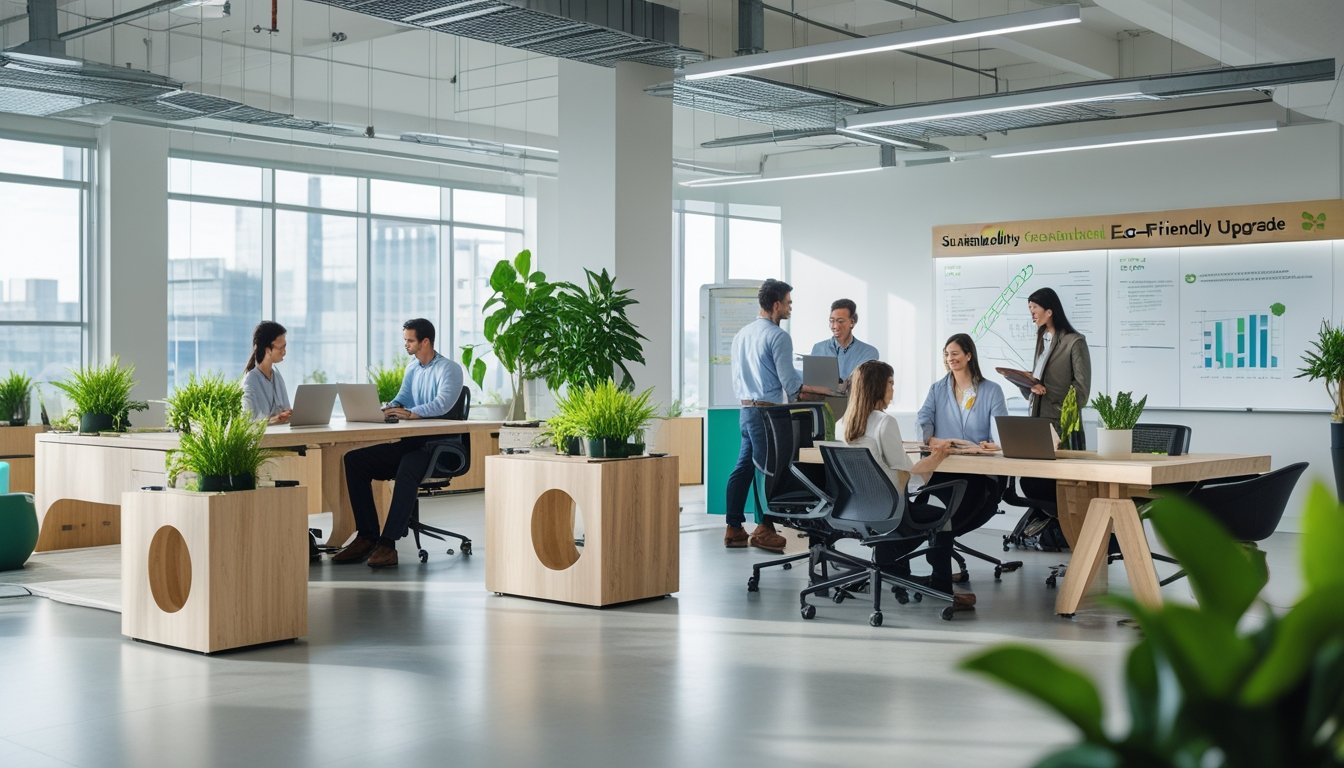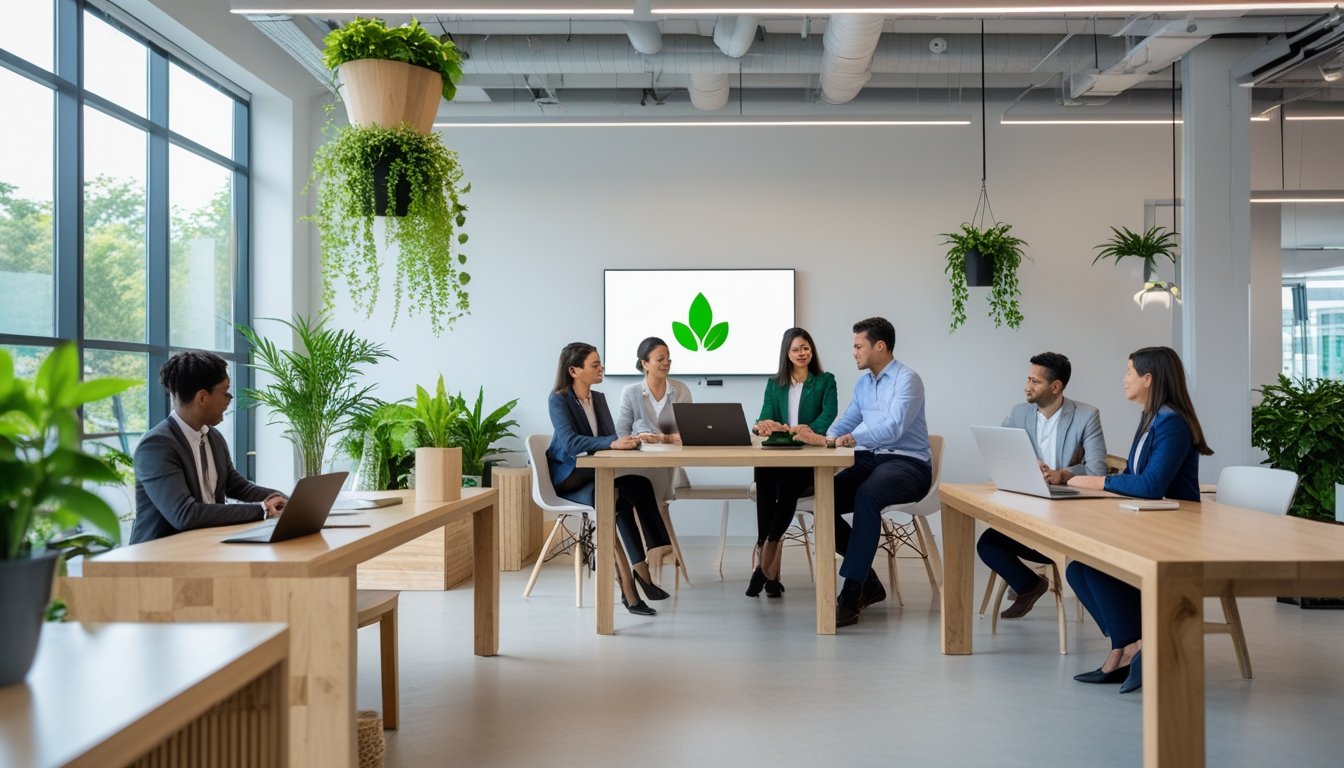Late updated: 26 Sep 2025 13:09
Written by: Amber Collins
Exploring Eco-Friendly Office Space Enhancements: Sustainable Solutions for Modern Workspaces
Creating an eco-friendly office space goes beyond merely recycling paper and plastic. It involves a thoughtful redesign and approach to how we use resources and space. By adopting energy-efficient systems and incorporating sustainable materials, we not only reduce our environmental impact but also foster a healthier and more productive environment for everyone. The momentum towards eco-friendly office enhancements is not just about conserving resources; it's about enhancing workplace efficiency and employee well-being.

As we explore the foundations of these enhancements, it becomes clear that small changes can lead to substantial benefits. Incorporating natural elements and optimising light sources can transform a workspace into a more uplifting and productive environment. By aligning our office designs with sustainable principles, we contribute to a more conscious workplace culture.
The strategies we employ in crafting a sustainable office determine the future of our workspaces. Energy-efficient lighting, green rooftops, and the use of renewable materials present opportunities for creativity and innovation. A commitment to eco-friendly practices can revolutionise the way we work, merging comfort with responsibility.
Key Takeaways
- Eco-friendly offices boost efficiency and well-being.
- Small design changes make big sustainability impacts.
- Sustainable practices shape future workspaces.
Foundations Of Eco-Friendly Office Space Enhancements

Creating eco-friendly office spaces involves implementing sustainable practices and reducing environmental impacts. We will explore sustainable workplace principles and strategies to minimise the carbon footprint of office environments.
Principles Of Sustainability In The Workplace
A key principle of sustainability is the usage of resources in a manner that meets present needs without compromising future generations. In our approach, we focus on selecting eco-friendly materials, promoting renewable energy, and ensuring energy efficiency in office spaces.
By incorporating energy-efficient lighting and heating, ventilation, and air conditioning (HVAC) systems, we reduce our energy consumption significantly. The choice of furniture and materials also plays a critical role. Utilising recyclable, non-toxic, or repurposed materials, such as bamboo and reclaimed wood, contributes to a greener workplace.
Integrating green spaces within the office, like indoor plants, helps improve air quality and employee morale. Initiating employee engagement programmes to encourage environmentally responsible behaviours is equally vital. Our aim is to embed sustainability into every facet of office operations, fostering a culture of environmental responsibility.
Reducing The Environmental Impact Of Office Spaces
Minimising environmental impact involves conscious choices that reduce waste and emissions. Recycling programmes and waste management systems are instrumental in this process. By setting up recycling stations and encouraging composting, we can cut down on landfill contributions.
Water conservation is another crucial aspect. Installing water-saving fixtures helps reduce consumption and preserve this precious resource. Encouraging a paperless environment and opting for digital solutions further diminishes our environmental footprint.
Transportation options are also considered. Promoting telecommuting or providing incentives for carpooling and using public transport can effectively reduce greenhouse gas emissions. Sustainable office design is not a one-time setup but an ongoing commitment to making conscientious decisions that reflect our commitment to the planet’s well-being.
Key Strategies For Sustainable Office Upgrades

Upgrading office spaces sustainably can significantly minimise environmental impact. Key strategies focus on energy-efficient lighting, intelligent climate control, sustainable materials, and improved indoor air quality. These enhancements not only contribute to a greener workspace but also boost employee wellbeing and productivity.
Energy-Efficient Lighting Solutions
Utilising energy-efficient lighting is crucial for reducing energy consumption in office spaces. LED lighting is an excellent option, providing longer lifespan and lower energy usage compared to traditional bulbs. Equipping offices with LED bulbs and motion sensors ensures lights are only on when needed, further conserving energy. Implementing lighting controls such as dimmers and timers also optimises energy savings. Solar panels can additionally be considered to power lighting systems sustainably, lowering dependency on non-renewable resources.
Intelligent Climate And Energy Management
Implementing intelligent climate and energy management systems can significantly decrease energy consumption. Smart thermostats allow precise temperature control, ensuring optimal comfort while reducing energy waste. By scheduling heating and cooling based on occupancy, we can achieve substantial savings. Utilising motion sensors to adjust climate control settings in unoccupied areas further conserves energy. Integrating solar panels into our energy strategy can also provide a renewable energy source for heating and cooling needs.
Sustainable Material And Furniture Choices
Choosing sustainable materials for office upgrades promotes eco-friendliness and durability. Opting for furniture made from reclaimed wood or materials certified by entities like Green Seal minimises environmental impact. Glass partitions allow natural light to permeate the space, reducing the need for artificial lighting during the day. Emphasising recyclable and non-toxic materials in office design ensures a healthier workplace for everyone. Considering the lifecycle and recyclability of materials used also contributes to sustainability goals.
Improving Indoor Air Quality
Improving indoor air quality is essential for a healthier workplace environment. Incorporating air purification systems helps eliminate pollutants and allergens, enhancing air quality. Integrating indoor plants, such as spider plants, contribute to cleaner air by naturally filtering toxins. Setting up regular maintenance and cleaning routines for HVAC systems and air filters ensures optimal performance and air quality. Encouraging the use of non-toxic cleaning products also supports a safe and healthy indoor environment.
Frequently Asked Questions

In enhancing eco-friendly office spaces, reducing energy consumption, promoting sustainable waste management, and improving air quality are key areas of focus. Incorporating sustainable furniture and encouraging green commuting also contribute substantially to an environmentally-friendly workspace.
What are the most effective ways to reduce energy consumption in an office environment?
Reducing energy consumption can be achieved through the installation of energy-efficient lighting and smart climate control systems. Retrofitting windows and upgrading insulation are also effective measures. By encouraging workers to power down equipment when not in use, we can further minimise unnecessary energy use.
How can offices implement sustainable waste management practices?
Offices can implement sustainable waste management by initiating recycling programmes for paper, plastics, and electronic waste. Utilising digital communication tools can decrease paper usage significantly. Composting organic waste from office kitchens also contributes to more sustainable practices.
In what manner can indoor air quality be improved through eco-friendly modifications?
Improving indoor air quality can be addressed by incorporating air-purifying plants and installing advanced ventilation systems. Using low volatile organic compound (VOC) paints and materials can reduce harmful airborne substances. Regular maintenance of HVAC systems also ensures cleaner air circulation.
What options are available for sourcing sustainable office furniture and supplies?
Sustainable office furniture can be sourced from companies that use renewable materials like bamboo and reclaimed wood. Suppliers offering recycled or environmentally certified products provide an eco-friendly option. Opting for modular furniture designs can also extend the lifecycle of office furnishings.
How does the integration of green spaces within the office setting contribute to environmental well-being?
The integration of green spaces, including indoor plants and biophilic designs, enhances employee well-being by reducing stress and promoting focus. It also improves air quality and can result in a more pleasant work environment. Green roofs and walls are additional options that offer environmental and aesthetic benefits.
Can you suggest methods for promoting sustainable commuting among office employees?
Promoting sustainable commuting can be achieved by offering incentives for using public transportation or carpooling. Providing secure bike storage and shower facilities can encourage cycling to work. Implementing flexible working hours or remote work options can also reduce the need for daily commuting.
